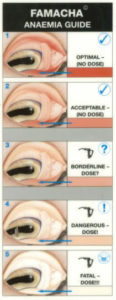Main Content
Sadly, parasitic worms are a problem that affects most animals. But as animal owners, we treat our animals with de-wormer and BAM the nasty creatures are gone. Problem solved, right? Well, it may not be that easy anymore…..
A growing concern for many alpaca and llama owners is anthelmintic (dewormer) resistance by the barber’s pole worm (Haemonchus contortus). These worms are a virulent blood-feeding nematode that causes weight-loss, weakness, anemia, hypoproteinemia (low blood proteins), dependent edema, diarrhea, and possibly even death. Barber’s pole worm drug resistance has been a well-documented problem on small ruminant farms, but what does that mean for camelid owners and farms?
In an article published by Alpacas Magazine, Dr. Lisa Williamson talks about a research study conducted by scientists from the University of Georgia, College of Veterinary Medicine. The scientists studied 32 privately owned camelid farms, 16 alpaca and 16 llama, to determine if anthelmintic resistance was evident in the barber’s pole worm populations on those farms. Anthelmintic resistance is the genetic ability of a worm to survive or “resist” a dose of dewormer that would normally be effective to kill it. According to Dr. Williamson, the results of the study clearly showed that dewormer resistance was present to some degree on all the camelid farms tested. She stated that 100 percent of the farms tested had benzimidazole resistant barber’s pole worms and 97 percent of the farms had ivermectin resistance. Fenbendazole and albendazole are both examples of a benzimidazole drug. The study found that levamisole and moxidectin had the lowest amount of resistance (22 percent).
Dr. Williamson went on to discuss the effectiveness of the FAMACHA™ score in llama and alpaca herds where the barber’s pole worm is an issue. FAMACHA™ scoring identifies anemia in small ruminants which is the main symptom of barber’s pole worm infestation. The scale was developed by Dr. Faffa Malan and is a five color chart that corresponds to a sheep or goat’s bottom eyelid color. The scientists from the University of Georgia, College of Veterinary Medicine validated the FAMACHA score card for use with alpacas and llamas and concluded that it was a useful tool in camelid herds where infestations of barber’s pole worm is a concern.
Dr. Williamson concluded the article with information about steps to take to limit the spread of drug resistant worms. She stresses the importance of quarantining new animals to the farm and having a fecal egg count test done. Talk to your veterinarian as to the best way to keep your alpacas and llamas safe from these pesky, super drug resistant worms!
Written by Michelle Teitsma, 4-H Program Associate
Featured Resource: Drug Resistant Worms: Anthelmintic Resistance is a Growing Concern for Alpaca Owners, written by Dr. Lisa Williamson, Professor in the Department of Large Animal Medicine at the University of Georgia, College of Veterinary Medicine. Published by Alpaca Magazine, Autumn 2013.